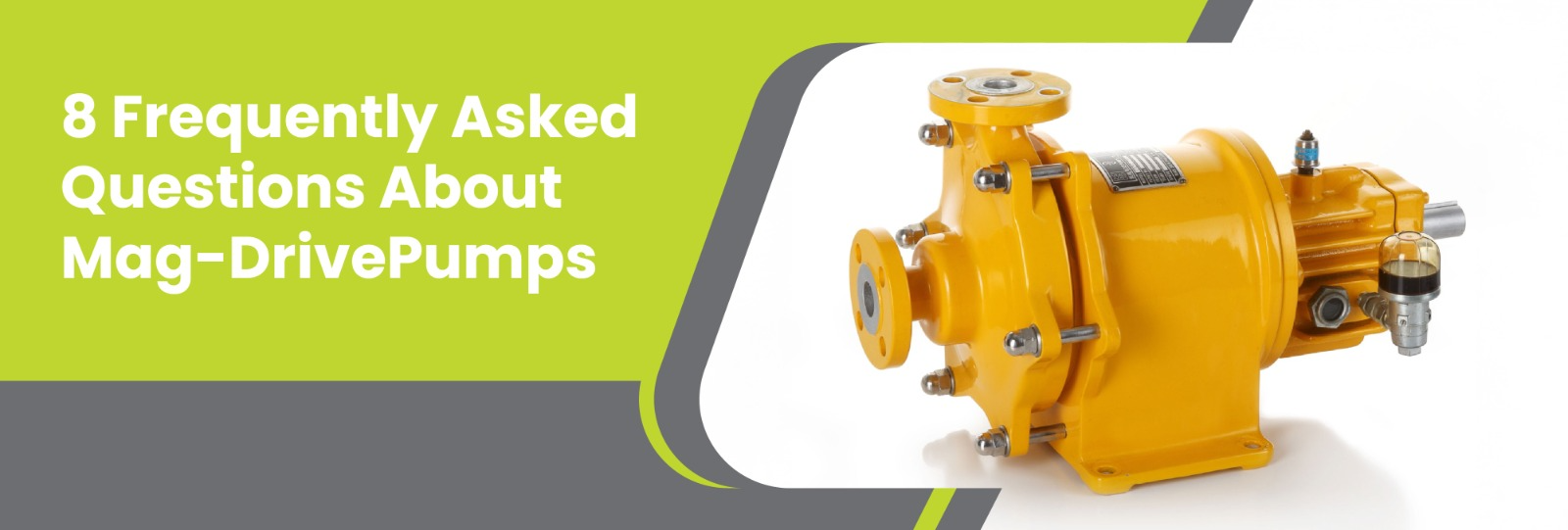8 Frequently Asked Questions About Mag-Drive Pumps

Industrial magnetic drive pumps, or mag-drive pumps, are becoming the go-to in industries that demand leak-proof, low-maintenance fluid handling. If you're wondering how they work, where they're used, mag-drive pump maintenance tips or how they differ from traditional pumps, this FAQ guide has it covered.
1) What is a mag-drive pump, and where are they used?
A mag-drive pump, also known as an industrial magnetic drive pump, uses a magnetic field to transfer power from the motor to the impeller. There is no direct connection between them, which means it is a seal-less pump technology. Common applications of magnetic drive pumps are chemical processing, pharmaceuticals, water treatment, electronics manufacturing, and any system requiring leak-free handling of corrosive or hazardous fluids.
Common applications of magnetic drive pumps are chemical processing, pharmaceuticals, water treatment, electronics manufacturing, and any system requiring leak-free handling of corrosive or hazardous fluids.
2) How does a mag-drive pump work?
A mag-drive pump works using magnetic coupling instead of a direct mechanical connection between the motor and the impeller. Here's the basic mag-drive pump working principle:
- The motor turns a drive magnet.
- This drive magnet creates a magnetic field.
- Inside the pump housing, a driven magnet (attached to the impeller) spins in response.
- As the impeller rotates, it moves the fluid.
3) What are the main benefits of mag-drive pumps?
The key benefits of mag-drive pumps are due to the seal-less pump technology, which makes them safer and easier to maintain than traditional pumps.
No leakage: With no mechanical seals, there is zero risk of fluid leaks—ideal for corrosive or hazardous chemicals.
Low maintenance: With fewer moving parts and no seals to replace, downtime and service costs are reduced.
Corrosion resistance: Most mag-drive pumps for chemicals are made with corrosion-resistant materials.
Compact and reliable: Their simple design enhances reliability in demanding industrial environments.
Energy efficiency: Minimal energy loss due to direct magnetic drive and smooth flow.
4) How do temperature limits affect mag-drive pump performance and reliability?
Temperature directly impacts the magnet strength and internal components of industrial magnetic drive pumps. If operating temperatures exceed the material limits, the magnets can weaken, leading to decoupling and pump failure.
Heat also stresses bearings, bushings, and containment shells, reducing service life.
Unstable conditions, such as dry runs or closed discharge, can cause sudden temperature spikes. So, proper material selection and thermal protection are critical for reliable long-term performance.
5) Is dry running a critical failure mode in mag-drive pumps, and how can it be prevented?
Yes, dry running is one of the most critical failure modes for industrial magnetic drive pumps. Since these pumps rely on the pumped liquid for cooling and lubrication, running without fluid causes rapid heat buildup. This can lead to:
Bearing and bushing failure
Magnet decoupling due to overheating
Permanent damage to the containment shell
To prevent this, systems often include a power monitoring device. During a dry run, the pump draws less power. This drop is detected, and the monitor shuts the pump off before damage occurs.
6) Can mag-drive pumps handle slurries or abrasive media?
Mag-drive pumps are not ideal for slurries or abrasive fluids. The internal components, especially sleeve bearings and bushings, can wear quickly when exposed to solids. Even small particles can cause scoring, increased friction, and premature failure.
If the application demands some solids handling, consider the following:
Adding a strainer or filter upstream
Using harder materials (like ceramic or SiC) for internal parts
Evaluating whether some other pump is a better fit.
7) What are common failure points in mag-drive pumps, and how do you troubleshoot them?
Some of the most common failure modes include:
Magnet decoupling: Often caused by overpressure, high viscosity, or temperature excursions. Check for system backpressure and fluid properties.
Dry running: Leads to bearing and magnet damage. Confirm the presence of the flow and check the power monitoring trip logs.
Abrasion or wear: Caused by solids in the fluid. Inspect for scoring on bushings or impeller surfaces.
Overheating: Results from low flow, blocked discharge, or incorrect magnet material.
Always refer to the manufacturer's mag-drive pump troubleshooting guide for accurate diagnostics. For complex or recurring issues, consult the manufacturer directly to avoid missteps or equipment damage.
8) How to maintain a mag-drive pump?
Mag-drive pumps are low-maintenance because of their seal-less pump technology. But they're not maintenance-free. Here are a few mag-drive pump maintenance tips
Ensure proper operating conditions: Never run dry, maintain minimum flow and avoid pressure spikes and cavitation.
Monitor key metrics: Track power draw and flow rate. Make sure you use temperature sensors.
Inspect internal components during shutdowns: Check bearings, busing, and impeller for signs of abrasion, scoring or magnet weakening.
Keep the system clean: Filter out solids and flush the pump regularly.
Follow OEM service intervals: Use the manufacturer's mag-drive pump maintenance and troubleshooting guide and replace wear parts as recommended.
Conclusion
Magnetic drive pump vs centrifugal pump is a common comparison when selecting equipment for chemical or hazardous fluid handling, especially where leak prevention and low maintenance are priorities. When correctly selected and operated, magnetic drive pumps are the preferred solution for many demanding applications because of their seal-less pump technology.
Looking for reliable magnetic drive pumps for your process needs? Get in touch with Mascot Dynamics.